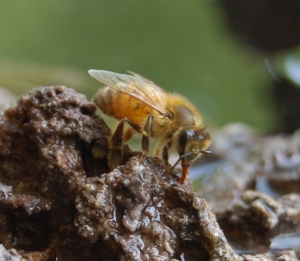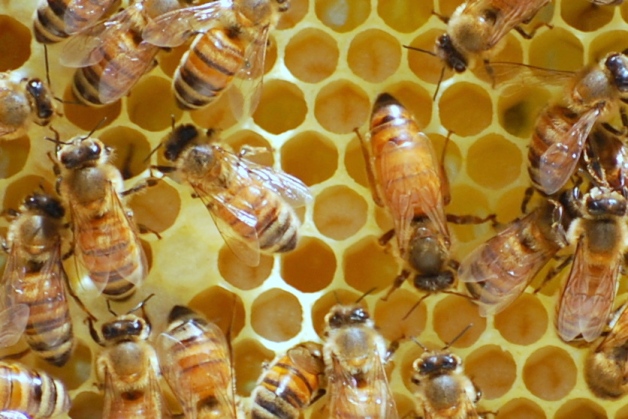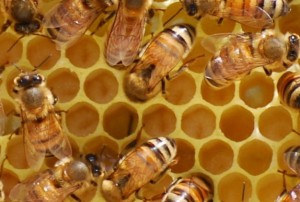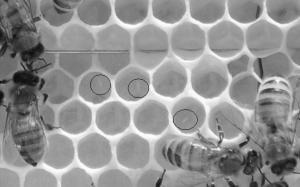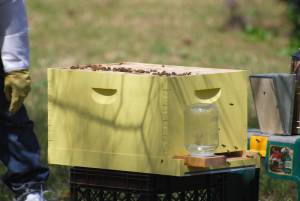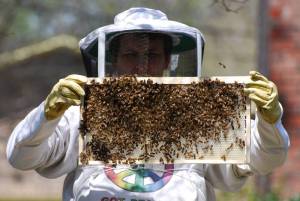March 25, 2010
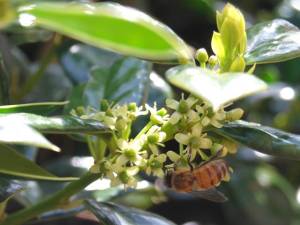
One of our worker bees working our holly blossoms.
Last night I caught a swarm of bees! This was a completely unexpected turn in my plans tobegin beekeeping, and in fact is what I feel has moved me from student to actual beekeeping.
I first heard about the swarm on a friend’s Facebook page. She sounded curious but also seemed to want the swarm to leave. As she put it, she would like to “encourage the bees to move on.” I decided to call her up and see if the swarm was still there and whether it would be all right for me to come and retrieve it. She agreed, and I set about convincing my family that I needed to go leave in the midst of bedtime routines for the children. My daughter said that she would be fine and could do bedtime with her father, and he said, “Go, go!” Happily I began to get ready.
I gathered protective clothing (my hat and veil, long sleeve gloves, a bulky sweatshirt, and rubberbands for my pants) and a few tools (a nuc box†, a couple of pruning shears, and a flashlight). This being my first time to do this, I wasn’t sure that I had everything that I needed, but I decided to be satisfied with this. I fired up the car’s GPS, and I was ready to roll.
On the way, I tried to calm myself, worried that my adrenaline levels would make the bees more agitated. In the end, this proved not to be a significant factor, because although I constantly felt charged up, I was able to remain calm and move carefully and slowly throughout the process. When I found my friend’s home, we checked to see whether the bees were still there, and as I suspected, they had not moved away in the chilly evening. I felt relatively sure that since night had fallen, this swarm would not be inclined to move on to their newly scouted out location for a new hive until the next day.
The swarm was wonderfully located for me, since this was my first experience. It was in a small bush, about 3 feet from the ground, and only about 1 foot into the loosely defined shrub. It was easy to move the branches surrounding the swarm without disturbing it. The swarm itself was about the size of a very large grapefruit and very compact. The bees were huddled together and buzzing quietly. My friend helpfully positioned her car so that the headlights would light up the swarm while I worked.
After assessing the branch leading up to the swarm, I realized that I would not be able to cut it with my pruning tools without disturbing the swarm significantly, so I opted for a different approach. I held my open nuc box under the swarm and jerked the branch sharply down onto the box, causing most of the swarm to drop into the box. Of course, many of the bees were angered by this move, and they began flying around me rather aggressively. I soon felt a prick of a stinger that had managed to penetrate my blue jeans at my hip. However, I realized later that this stinger remained stuck in my pants and did not stay in my skin very long, so not much venom was delivered.
I carefully placed the lid back on the nuc box to contain as many of the bees in the swarm as possible. I felt hopeful that the queen was in the box at this point, but I had already noticed that a significant number of bees were re-congregating on the bush at the same location. I waited a short time for the bees to settle down, and the remaining bees formed a clump about the size of a baseball. I wanted to be sure that I had obtained the queen, so I decided to take these bees as well. I decided to try to cut off the branch to retrieve the remaining bees. My friend lent me a small hand saw, and I managed to cut about halfway through the branch before I decided that the bees were getting a little too agitated by the vibration of sawing. After a bit of gentle manipulation, I was able to break off the branch without overly disturbing the bees, although a few began buzzing around my head.
Now I had the branch in hand, and I carried it gently to the nuc box and laid it down on the driveway while I prepared to open the nuc box. About this time, I was surprised to be stung on the forehead. I checked my veil and realized that my hat had slipped underneath my veil and left an opening on the top of my head. I rearranged my hat carefully before proceeding.
The bees inside the box had settled somewhat, but I knew that they would be agitated when I opened the box again. I pruned off some of the longer small branches that were protruding from the remaining cluster of bees. Then I opened the nuc, placed the foliage with the cluster into the box, and closed the box again.
At this point, I had finished my task of retrieving the swarm. I began to gather up my tools and moved the nuc away from the area in order to avoid a gathering of bees around the outside of the box. Then I asked my friend if I could come inside and remove the stinger from my forehead. It had been there for about 10 minutes, and it was a hurtin’! On a side note, when removing a stinger, be careful not to squeeze the small venom sack that is attached to the stinger, or you will simply deliver more venom into your skin. Gently scraping the stinger out of your skin is the best way to remove it.
After answering a few questions, I was ready to head home. The homeowners were of course primarily concerned that the swarm was going to build a hive right there in their bush or perhaps try to take up residence in the structure of their home. The latter is a valid concern, and this is a fine reason to ask a local beekeeper to come and remove a swarm from your property. It is unclear whether many honey bee colonies are able to survive on their own due to the multiple insults they face in recent years. For that reason, having a beekeeper come and take the swarm to a managed environment may be the best solution for the bees as well.
I was away from home less than 2 hours, and I believe that the removal of the swarm took about one hour. This was a really easy situation to handle, which is a good thing for me. This is my first experience handling any bees at all, and I made a few mistakes. There are things I would have liked to have done differently.
First, I should have taken the extra 10 minutes to stop by the pharmacy to pick up my epi-pen, which was waiting for me. This is simply a safety precaution, as I have no known allergies to bee stings, but it definitely would have been smarter to do this. Second, I should have taken a spray bottle with water or a sugar solution. If I had sprayed the swarm with this before manipulating it, the bees would have been much calmer, and their ability to fly would have been hampered temporarily. Third, I would have like to have had better pruning shears that I could handle one-handed on a one inch branch. What seems obvious in retrospect is that one hand must be free to hold the branch leading up to the swarm so that it will not fall when cut off from the rest of the plant.
That being said, I had fun, and I believe that little harm came to the bees in my encounter. Perhaps I would have managed to retrieve more of them had I brought the spray bottle, but I believe that I did manage to bring home 90% of the swarm.
After getting the bees safely back to my home, I sprayed them (through the screen of the nuc) with sugar syrup so that they would have some liquid and some calories to get them through the night. It was late enough by this time that I didn’t want to move them again. I was afraid that if I acted too hastily, I might make more mistakes, and I was very tired.
This morning, I set up one of my wooden hives, which was ready to receive bees, in my yard. I also placed a drip feeder in the entrance of the hive. I moved the nuc out to the yard, next to the hive. When I looked inside through the screen, I could see that most of the bees were clustered on the inner cover of the box, while some were clustered around the branch that I had placed into the box. I donned my protective equipment, sprayed the bees again with sugar syrup, and opened the box carefully. Those bees on the inside of the lid of the box stayed with it, and I sprayed all around the cluster. I placed the box lid over the hive body (I had removed 4 frames to make room for the swarm to hang into the hive body), then banged it onto the wooden box. The swarm fell into the hive body. I did the same with the cluster on the branch, then began replacing the 4 frames gently. I closed up the hive and left the mostly empty nuc next to the hive for a few minutes to allow any remaining bees to enter the new hive. Then I cleaned up my tools and left the bees to explore their new digs.
Within a few hours, the bees were exploring the holly bushes in my yard, which are just beginning to bloom. It is a wonderful sight to see them working the holly so quickly, and they are quite busy moving in and out of the hive. At the end of the day, I took my 5 year old daughter out with her veil so that she could see the bees moving around the entrance of the hive. She is very excited about all of this, and I couldn’t be more pleased.
In a couple of days, I will check on the inside of the hive to see if the bees are drawing comb and to see if I can locate the queen. This will be my next big test as a beekeeper!
————————————————
